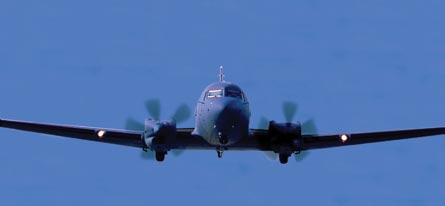Reporting on the biggest oil-spill disaster in history, the biggest newspaper in New Orleans - the Times-Picayune - alerted readers on 21 July that help was on the way.
"A New Orleans company ordered the purchase of a high-tech plane," the Times-Picayune reported in a front-page story, describing the $6.5 million aircraft as the "biggest investment in Gulf spill cleanup in the past two decades".
It was the Basler Turbo BT-67, an airframe that could be considered modern only by geological standards.
|
|---|
By virtue of a commercial misjudgement by the founder of Basler Turbo Conversions of Oshkosh, Wisconsin, the BT-67 has breathed new life into an aircraft widely credited for establishing the model for financially-viable air transport in a very different era.
The BT-67 referenced by the Times-Picayune arrived with an oil-dispersant system, which is one of dozens of commercial applications enabled by converting DC-3s and C-47s into turboprop-powered, special mission aircraft. Dozens of BT-67s are currently in service in the world's most remote areas, including the arctic, deserts and jungles.
MONITORING AND MILITARY USES
Oil companies use them to scout for geologic formations, scientists fly in them to monitor the earth's climate and militaries operate them as both surveillance aircraft and gunships.
At a time when nearly all aircraft designed before World War II are limited to nostalgic appearances at air shows, if they remain serviceable at all, the BT-67 preserves the DC-3 design as the operational workhorse that it was intended for at least another 25 years and perhaps beyond.
For as many of its contemporary American pre-war types still in service, there are perhaps 10 DC-3s, C-47s and BT-67s flying operational missions around the world.
(To interact with timeline hover over the rightside to move along.)
The BT-67 is itself the product of a commercial misjudgement, although redeemed partly through success in the niche market for special mission applications.
Before the Basler company was a house of DC-3 conversions, it was a regional airline operating the piston-powered aircraft. Basler Airlines established a niche flying local patrons to resorts in Canada on the airline version and automotive parts between Midwest factories with the cargo version.
The company's founder, Warren Basler, eventually recognised a need for a new aircraft to replace the venerable DC-3.
"He realised the engine reliability [of the DC-3] was not something you could build your business around," says Tom White, president of Basler Turbo Conversions.
|
|---|
SWEET SPOT In considering for replacement options, Basler determined the cargo box size of the DC-3 was still in the sweet spot even five decades beyond its heyday. Basler focused especially on the need to replace cargo DC-3s then operated by FedEx across the Midwest from Oshkosh to Detroit to Cleveland. "He just couldn't find [an ideal DC-3 replacement] so he set down the path of redoing," White says. "That size has always been the dream of small-package people to feed their operations."
In considering for replacement options, Basler determined the cargo box size of the DC-3 was still in the sweet spot even five decades beyond its heyday. Basler focused especially on the need to replace cargo DC-3s then operated by FedEx across the Midwest from Oshkosh to Detroit to Cleveland. "He just couldn't find [an ideal DC-3 replacement] so he set down the path of redoing," White says. "That size has always been the dream of small-package people to feed their operations."
On 18 April 1988, Basler Turbo Conversions applied for a supplemental Type Certificate, which proposed replacing the DC-3s Wright Cyclone or Wasp piston engines with Pratt & Whitney Canada PT6A-67R turboprops and Hartzell HC-B5MA-3/M11276 propellers. But the FedEx contract never materialised.
"That market just did not pan out to us," White says. "We shifted into the special mission market."
Designed in an era with little airport infrastructure, the DC-3 is able to deliver a large payload - 4,540kg (10,000lb) - to austere airfields. White notes that the DC-3 remains the largest commercial aircraft that can be equipped with skis for landing in the polar regions.
Finally, the DC-3 is designed with a large wing area for its size, which is a critical feature in surveillance and mapping flights.
"You can load up the most modern technology in the airplane," White says. "This type of equipment needs a real stable platform."
There is also no shortage of viable airframes that can be converted into the BT-67.
White estimates that Basler's current production volumes suggest an at least 30-year supply of aircraft. "It's not really a concern for us," he says. "It's only possible that some airplanes may be a little harder to get."
The DC-3 also appears to be robust enough to survive for several more decades.
"There's no Achilles heel on the airplane," White says. "The other thing is for most of our clients their flight hours tend to be a lot lower than, say, a passenger airliner, which might be flying 10, 12, 14 hours a day or more.
"Our customers just aren't that kind of a market."
Source: Flight International



















